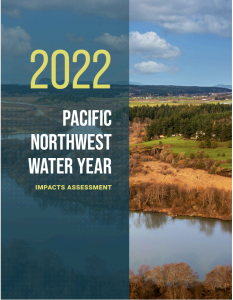PNW Water Year 2022 Impacts Assessment

The Pacific Northwest (PNW) Water Year 2022 Impacts Assessment is now available! Funded by the NOAA National Integrated Drought Information System, and produced through a collaboration of regional entities, this assessment summarizes the water year conditions and related impacts and responses by different sectors. The sector impacts covered in this report are drinking water, agriculture, forestry, fisheries, hydropower, recreation, and stormwater. This is the third water year impacts assessment, now joining a growing archive of both the 2020 and 2021 water years.
The 2022 Water Year Assessment focuses on the abrupt transitions between abnormal seasons. The water year was characterized by a dry winter (Jan- Mar was the 41st driest in Washington), shifting to a wet spring (Apr-Jun was the 3rd wettest in Washington), and then to a dry summer (Jul-Sep was the 2nd driest in Washington). The dry January-March conditions were even more anomalous in Oregon and Idaho. This sort of variability – on shorter time scales – has been the focus of recent highlight pieces of this newsletter, partially motivated by the swings in conditions seen over the last year. For the PNW, the assessment notes that these abrupt seasonal transitions were challenging for forecasting and operation planning in multiple sectors. Regarding agriculture, for example, the timing of the transition between dry (March 2022) and wet (April) was particularly challenging because it occurred when annual irrigation allotments were being considered. In this way, the abrupt shifts are more difficult to manage than the impacts from either abnormally dry or abnormally wet conditions alone, which is a nuance that may not have been as appreciated prior to the 2022 water year.
Another highlight from the assessment is the recognition, for the second year in a row, of the importance of spring PNW conditions in determining the magnitude and extent of drought. The record wet April-June in 2022 was the mirror image of the record dry April-June 2021 across the PNW. In 2022, the wet and cool spring drastically improved the outlook for drought for the remainder of the water year. For locations in Oregon and Idaho where drought was still experienced, it was much less severe than it otherwise might have been, and drought concerns were alleviated almost completely in Washington state. The caveat here being that the switch to a warm and dry July-September reversed some of that improvement.
We hope this small preview entices you to look through the assessment. Together with the 2020 and 2021 Water Year Assessments, we are working towards the goal of providing ongoing documentation of the specific conditions that cause impacts, and ultimately improving the management of drought and other climate-related impacts in the future.
Reference
Bumbaco, K.A., C.L. Raymond, L.W. O’Neill, A. Mehta, D.J. Hoekema. 2023. 2022 Pacific Northwest Water Year Impacts Assessment. A collaboration between the Office of the Washington State Climatologist, Climate Impacts Group, Oregon State Climatologist, Idaho Department of Water Resources, and NOAA National Integrated Drought Information System.